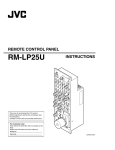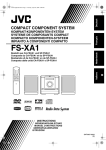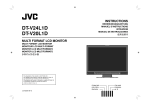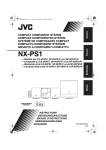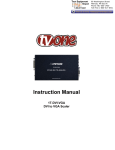Download JVC LT-20BW7BJ User's Manual
Transcript
LT-20BW7BJ WIDE LCD PANEL TV INSTRUCTIONS ENGLISH Dear Customer, This apparatus is in conformance with the valid European directives and standards regarding electromagnetic compatibility and electrical safety. European representative of Victor Company of Japan, Limited is: JVC Technology Centre Europe GmbH Postfach 10 05 52 61145 Friedberg Germany Warning DO NOT cut off the mains plug from this equipment. If the plug fitted is not suitable for the power points in your home or the cable is too short to reach a power point, then obtain an appropriate safety approved extension lead or adaptor or consult your dealer. If nonetheless the mains plug is cut off, remove the fuse and dispose of the plug immediately, to avoid a possible shock hazard by inadvertent connection to the mains supply. If a new mains plug has to be fitted, then follow the instruction given below: Important Do not make any connection to the larger terminal which is marked with the letter E or by the safety earth symbol or coloured green or green-and-yellow. The wires in the mains lead on this product are coloured in accordance with the following code: Blue: Neutral Brown: Live As these colours may not correspond with the coloured marking identifying the terminals in your plug proceed as follows: The wire which is coloured blue must be connected to the terminal which is marked with the letter N or coloured black. The wire which is coloured brown must be connected to the terminal which is marked with the letter L or coloured red. When replacing the fuse, use only a correctly rated approved type and always re-fit the fuse cover. If in doubt — consult a competent electrician. How to replace the fuse Open the fuse compartment with a blade screwdriver, and replace the fuse. Guidelines for safe operation This equipment has been designed and manufactured to comply with international safety standards. However, as with any electrical appliance, care must be taken to ensure optimal results and operational safety. • Before attempting to use this equipment, read the operating instructions thoroughly. • Ensure that all electrical connections (including the mains plug, extension leads, etc.) have been made in accordance with the manufacturer’s instructions. • If ever in doubt about the installation, operation or safety of this equipment, consult your dealer. • Handle all glass panels or covers with care. • Never operate this equipment if it appears damaged or operates abnormally. Turn the power off, disconnect the main power plug and consult your dealer. • Never remove any affixed panels or covers. Doing so may result in electrical shock. • Never leave this equipment operating unattended unless otherwise specifically stated that it is designed to do so or in standby mode. Only use the designated power switch to turn off the power and ensure that all potential users are instructed how to do so. Make special arrangements for infirm or handicapped persons. • Never watch TV while operating a motor vehicle. It is illegal to watch TV while driving. • Never listen to headphones at high volume. Doing so may damage your hearing. • Never obstruct the ventilation of this equipment. Doing so may cause overheating and result in a malfunction or damage. • Never use makeshift stands or attempt to affix legs with wood screws. When using a manufacturer’s approved stand or legs, use only the fixtures provided and follow the installation instructions. • Never allow this equipment to be exposed to rain or moisture. • Never allow anyone, especially children, to insert anything into an opening in the case. Doing so may result in a fatal electrical shock. • Never guess or take chances with electrical equipment of any kind. It is better to be safe than sorry. Thank you for buying this JVC LCD flat television. To make sure you understand how to use your new TV, please read this manual thoroughly before you begin. (“LCD” stands for Liquid Crystal Display.) WARNING: TO PREVENT FIRE OR SHOCK HAZARD, DO NOT EXPOSE THIS APPLIANCE TO RAIN OR MOISTURE. WARNING • Fingers may be trapped under the TV causing injuries. Hold the TV at the bottom in the middle, and do not allow it to tilt up or down. WARNING • The TV may fall causing injuries. Hold the bottom of the stand with your hand and tilt the TV up and down. • Do not allow children to hang from the TV, place their elbows on the TV or lean against the TV. Doing so may cause the TV to fall over and lead to injuries. CAUTION • The TV screen may be damaged if the TV is carried as shown in the diagram on the right. 1 Pixel defects LCDs use collections of fine points (“pixels”) to display images. While there is no problem with more than 99.99% of these pixels, please understand that a very small number of pixels may not light, or may light all the time. Distance recommendations Avoid improper installation and never position the unit where good ventilation is impossible. When installing this TV, distance recommendations must be maintained between the set and the wall, as well as inside a tightly enclosed area or piece of furniture. Keep to the minimum distance guidelines shown for safe operation. Failure to take the following precautions may cause damage to the television or remote control. DO NOT block the TV’s ventilation openings or holes. (If the ventilation openings or holes are blocked by a newspaper or cloth, etc., the heat may not be able to get out.) DO NOT place anything on top of the TV. (such as cosmetics or medicines, flower vases, potted plants, cups, etc.) DO NOT allow objects or liquid into the cabinet openings. (If water or liquid is allowed to enter this equipment, fire or electric shock may be caused.) DO NOT place any naked flame sources, such as lighted candles, on the TV. DO NOT subject the TV to direct sunlight. Make enough room for inserting and removing the power plug! Place the TV as close to the outlet as possible. The main power supply for this TV is controlled by inserting or removing the power plug. The surface of the TV screen is easily damaged. Be very careful with it when handling the TV. Should the TV screen become soiled, wipe it with a soft dry cloth. Never rub it forcefully. Never use any cleaner or detergent on it. If there is a fault, unplug the unit and call a service technician. Do not attempt to repair it yourself or remove the rear cover. 2 Cleaning the screen The screen is coated with a special thin film to reduce reflection. If this film is damaged, uneven colors, discoloration, scratches, and other problems that cannot be repaired may occur. Pay attention to the following when handling the screen. • Do not use glue or adhesive tape on the screen. • Do not write on the screen. • Do not allow the screen to come in contact with any hard objects. • Do not allow condensation to form on the screen. • Do not use alcohol, thinner, benzene or other solvents on the screen. • Do not rub the screen hard. CAUTION: • Operate only from the power source specified (AC 220 – 240 V, 50/60 Hz) on the unit. • Avoid damaging the AC plug and power cord. • When you are not using this unit for a long period of time, it is recommended that you disconnect the power cord from the main outlet. Information for Users on Disposal of Old Equipment [European Union] This symbol indicates that the electrical and electronic equipment should not be disposed as general household waste at its end-of-life. Instead, the product should be handed over to the applicable collection point for the recycling of electrical and electronic equipment for proper treatment, recovery and recycling in accordance with your national legislation. Attention: This symbol is only valid in the European Union. By disposing of this product correctly, you will help to conserve natural resources and will help prevent potential negative effects on the environment and human health which could otherwise be caused by inappropriate waste handling of this product. For more information about collection point and recycling of this product, please contact your local municipal office, your household waste disposal service or the shop where you purchased the product. Penalties may be applicable for incorrect disposal of this waste, in accordance with national legislation. (Business users) If you wish to dispose of this product, please visit our web page www.jvceurope.com to obtain information about the take-back of the product. [Other Countries outside the European Union] If you wish to dispose of this product, please do so in accordance with applicable national legislation or other rules in your country for the treatment of old electrical and electronic equipment. 3 CONTENTS Setting up your TV ...................................5 Installation.................................................. 5 Using the stand .......................................... 5 Connecting the aerial and video cassette recorder (VCR) ....................................... 6 Connecting the power cord to the AC outlet....................................................... 7 Putting the batteries into the remote control..................................................... 7 Initial settings (Setup tour) ......................... 7 TV buttons and functions........................9 Turn the TV on from standby mode ........... 9 Choose a TV channel ................................ 9 Watch images from external devices ......... 9 Adjust the volume .................................... 10 Using the Menu........................................ 10 Remote control buttons and functions 11 Turn the TV on or off from standby mode 11 Choose a TV channel and watch images from external devices ........................... 11 Adjust the volume .................................... 12 Information function ................................. 12 ZOOM function......................................... 13 Hyper Sound function .............................. 14 Sleep Timer function ................................ 14 Sound Mode function ............................... 15 Picture Mode function .............................. 15 Operating a JVC brand VCR or DVD player.................................................... 16 Teletext function ....................................17 Basic operation ........................................ 17 Hold.......................................................... 17 Sub-page ................................................. 17 Reveal...................................................... 17 Size .......................................................... 18 Index ........................................................ 18 Cancel...................................................... 18 Using the TV’s menu..............................19 Basic operation ........................................ 19 Picture menu ..........................................20 Picture Mode............................................ 20 Bright-1 .................................................... 20 Contrast ................................................... 20 Colour ...................................................... 20 Sharpness................................................ 20 Picture Reset ........................................... 20 Picture Advanced Setting......................... 20 Sound menu ...........................................22 Bass ......................................................... 22 4 Treble ....................................................... 22 Balance .................................................... 22 Hyper Sound ............................................ 22 Sound Mode............................................. 22 Sound Reset ............................................ 22 Install menu............................................ 23 Auto Program ........................................... 23 Manual Program....................................... 23 Program Edit ............................................ 24 Program List............................................. 25 Colour System.......................................... 26 Feature menu ......................................... 27 Language ................................................. 27 Aspect Ratio............................................. 27 Sleep Timer.............................................. 27 Child Lock ................................................ 27 Blue Back ................................................. 27 PC Setting menu .................................... 28 Auto.......................................................... 28 Dot Clock.................................................. 28 Clock Phase ............................................. 28 H. Position................................................ 28 V. Position ................................................ 28 Displaying a computer screen.............. 29 Connecting to the computer ..................... 29 Watching images from a computer .......... 29 Table of signals for each type of computer............................................... 29 Additional preparation .......................... 30 Connecting external equipment ............... 30 Troubleshooting .................................... 33 Specifications ........................................ 35 Setting up your TV • When you install the TV on the wall, only use a JVC wall mounting unit (optional) which is designed for this TV. • Make sure that the TV is installed on the wall by a skilled installer. Installation Cautions for installation • Install the TV in a corner on a wall or on the floor so as to keep cords out of the way. • The TV will generate a slight amount of heat during operation. Ensure that sufficient space is available around the TV to allow satisfactory cooling. See “Distance recommendations” on page 2. Using the stand This TV comes with a table top stand already attached. This stand can be used to adjust the direction of the TV screen up and down. Tilt the TV backwards and forward: While holding the bottom of the stand with one hand, push the top side of the TV to tilt it backward. To tilt the TV forward, pull the top side of the TV toward yourself. Cable holder A cable holder which is used to keep the connection cables tidy is attached to the back of the stand. Put the cables in the cable holder and make sure that they are properly routed. cable holder 5 Setting up your TV Connecting the aerial and video cassette recorder (VCR) • The connecting cables are not provided. • For further details, refer to the manuals provided with the devices to be connected. Caution • Turn off all the equipment including the TV before connecting anything. • Aerial cable is not supplied. Use a good quality 75-ohm coaxial cable. • Read the manual that came with the VCR before connecting. 75-Ohm Coaxial Cable If you are connecting a VCR, follow A → B → C in the next diagram. If you are not connecting a VCR, follow 1. 75-Ohm Coaxial Cable • You can watch a video using the VCR without doing C. For details, see your VCR instruction manual. • To connect additional external devices, please see “Connecting external equipment” on page 30. To Aerial input 21-pin SCART Cable AV IN/OUT Terminal 6 To Aerial Output Setting up your TV Connecting the power cord to the AC outlet Insert the AC plug on the power cord from the TV into an AC outlet. Caution • Operate only from the power source specified (AC 220 – 240 V, 50/60 Hz) on the unit. Initial settings (Setup tour) When the TV is first turned on, it goes into the initial settings mode and the Quick Setup menu will appear. Follow the instructions on the screen display to make the initial settings. button • Remove the AC plug from the outlet to completely disconnect the TV from the power supply. Putting the batteries into the remote control Use two AA/R6 dry cell batteries. Insert the batteries from the - end, making sure the + and - polarities are correct. • Follow the warnings printed on the batteries. • Battery life is about six months to one year, depending on how much you use the remote control. • The batteries we supply are only for setting up and testing your TV, please replace them as soon as you need to. • If the remote control does not work properly, replace the batteries. PICTURE/OK button MENU button 1 /4/ 2 / 3 buttons 1 Press the button on the remote control The TV turns on from standby mode. • Check that the AC plug on the power cord from the TV is connected to AC outlet. Remote control sensor Power lamp • If the Quick Setup menu does not appear this is because your TV has already been turned on for the first time. Use the “Language” and “Auto Program” functions to make the initial settings. For details, see “Language” on page 27 and “Auto Program” on page 23. 7 Setting up your TV 2 Press the 2 and 3 buttons to choose English. Then press the 4 button Quick Setup Language English Country U.K. Sound System I Search > 100% MENU: The on-screen display will then be in English. 3 Press the 2 and 3 buttons to choose the country where you are. Then press the 4 button Quick Setup Language Now, setting up is complete. Please enjoy your new JVC TV! English Country U.K. Sound System I Search > 100% MENU: When your country is selected, the Sound System will change automatically to suit. 4 Press the PICTURE/OK or 3 button to start the Search function Quick Setup Language English Country U.K. Sound System I Search > 5% MENU: The TV channels you receive are automatically stored in the Programme numbers (Pr.). • To stop the Search function: Press the MENU button. 8 After the TV channels have been registered in the Programme numbers (Pr.), the first stored TV channel will be displayed • If you want to, you can now edit the Programme numbers (Pr.) using the Program Edit function. For details, see “Program Edit” on page 24. • If a TV channel you want to view is not set to a Programme number (Pr.), you can set it using the Manual Program function. For details, see “Manual Program” on page 23. • The Search function does not set the Programme number Pr. 0 for your video cassette recorder. You will need to set this using the Manual Program function. TV buttons and functions Turn the TV on from standby mode Press the button to turn the TV on from standby mode When the TV is turned on, the power lamp lights green. To turn the TV off: Press the button again. The power lamp lights red. • The TV will turn off automatically when no TV input signal (not EXT input signals) is detected for 5 minutes. Caution • The button on the TV does not fully isolate the TV from the AC supply. If you are not going to use the TV for a long period, be sure to disconnect the AC plug from the AC socket. Choose a TV channel Press the P buttons to choose a Programme number (Pr.) Watch images from external devices Press the TV/AV/OK button to choose an EXT terminal TV mode Refer to the pages in parentheses for details. 1 Remote control sensor 2 Power lamp (page 7) 3 (Stand by) button (page 9) 4P buttons (page 9) 5 (Volume) buttons (page 10) 6 TV/AV/OK button (page 9) 7 MENU button (pages 10, 19) 8 Headphone jack (mini jack) (page 30) Last Programme number EXT modes EXT-1 EXT1 EXT-2 EXT2 EXT-2 S-VIDEO EXT2-S EXT-3 EXT3 EXT-3 S-VIDEO EXT3-S PC IN PC HDMI HDMI 9 TV buttons and functions Adjust the volume Press the (Volume) buttons The volume level indicator appears. Using the Menu Use the MENU button Refer to “Using the TV’s menu” (see page 19) for details of using the menu. 10 Remote control buttons and functions 1 2 3 4 5 6 7 8 9 0 = ~ ! @ # $ % Muting button Number buttons ZOOM button button (Text) button AV button 2 / 3 / 1 / 4 buttons P buttons buttons Information button (Standby) button Colour buttons PICTURE/OK button MENU button (Volume) buttons VCR/DVD/Teletext control buttons Stereo/Bilingual button VCR/TELETEXT/DVD switch Turn the TV on or off from standby mode Press the (standby) button to turn the TV on or off When the TV is turned on, the power lamp lights green. • The power can also be turned on by pressing the AV button, P buttons or Number buttons. • The TV will turn off automatically when no TV input signal (not EXT input signals) is detected for 5 minutes. Choose a TV channel and watch images from external devices Use the number buttons: Enter the Programme number (Pr.) of the channel using the number buttons Example: • Pr. 6 → press 0 and 6 • Pr. 12 → press 1 and 2 11 Remote control buttons and functions Use the P buttons: Press the P buttons to choose the Programme number (Pr.) you want Use the AV button: Press the AV button to choose an EXT terminal TV mode Last Programme number EXT modes EXT-1 EXT1 EXT-2 EXT2 EXT-2 S-VIDEO EXT2-S EXT-3 EXT3 EXT-3 S-VIDEO EXT3-S PC IN PC HDMI HDMI • If you choose an EXT terminal with no input signal, the EXT terminal name becomes fixed on the screen. • If you do not have a clear picture or no colour appears, change the colour system manually. See “Colour System” on page 26. • If you cannot hear the normal sound even if the picture of the TV channel appears normally, follow the description “Manual Program” on page 23 to use the Sound System function to change the Sound System setting. To return to a TV channel: Press the P buttons or Number buttons. To use the Programme number Pr. 0: When the TV and VCR are connected only by the aerial cable, choosing the Programme number Pr. 0 allows you to view images from the VCR. Set the VCR RF channel to the Programme number Pr. 0 manually. For details, see “Manual Program” on page 23. 12 Adjust the volume Press the buttons to adjust the volume. The volume level indicator appears and the volume changes as you press the buttons. Muting the sound Press the (muting) button to turn off the sound Pressing the (muting) button again restores the previous volume level. Information function You can see the channel number of the programme you are watching. The channel number and channel name (when the channel name is registered) of the programme you are watching or the EXT terminal name is displayed. Press the (Information) button to display the information you want to see. Remote control buttons and functions ZOOM function You can change the screen size according to the picture aspect ratio. Choose the optimum one from the following ZOOM modes. • The ZOOM mode is fixed at Full when 1080i or 720p component video (HDMI) signal is displayed. • Only Full and Regular can be selected when you are using the TV as a PC screen. Auto: When a WSS (Wide Screen Signalling) signal, which shows the aspect ratio of the picture, is included in the broadcast signal or the signal from an external device, the TV automatically changes the ZOOM mode to 16:9 Zoom mode or Full mode according to the WSS signal. • When the Auto (WSS) mode does not function correctly due to poor WSS signal quality or when you want to change the ZOOM mode, press the ZOOM button and change to another ZOOM mode. Regular: Use to view a normal picture (4:3 aspect ratio) as this is its original shape. Panoramic: This stretches the left and right sides of a normal picture (4:3 aspect ratio) to fill the screen, without making the picture appear unnatural. 16:9 Zoom: This zooms up the wide picture (16:9 aspect ratio) to the full screen. 16:9 Zoom Subtitle: This zooms up the wide picture (16:9 aspect ratio) with subtitles to the full screen. Full: This uniformly stretches the left and right sides of a normal picture (4:3 aspect ratio) to fill the wide TV screen. • For 16:9 aspect ratio pictures that have been squeezed into a normal picture (4:3 aspect ratio), use the Full mode to restore the picture to its original shape. Choose the ZOOM mode Press the ZOOM button to choose a ZOOM mode The picture expands and the chosen ZOOM mode is displayed instantly. To select other ZOOM modes, press the ZOOM button several times. • The top and bottom of the picture are slightly cut off. 14:9 Zoom: This zooms up the wide picture (14:9 aspect ratio) to the upper and lower limits of the screen. 13 Remote control buttons and functions Hyper Sound function You can enjoy sounds with a wider ambience. • This function also works for the sound from headphones. Press the button to turn on or off the Hyper Sound function Hyper Sound On Sleep Timer function You can set the TV to automatically turn off after a set period of time. Press the yellow button several times to turn on the Sleep Timer function and set the period of time You can set the period of time for up to 120 minutes (2 hours) in 10 minute steps. Hyper Sound Off Off Minutes 10 Minutes Sleep Timer (10 Minutes) 20 Minutes Sleep Timer (20 Minutes) ......... • You can also turn on or off the Hyper Sound function with the “Sound menu” (see page 22). Sleep Timer Off 120 Minutes Sleep Timer (120 Minutes) To cancel the Sleep Timer function: Press the yellow button to set the period of time to “Off”. • The Sleep Timer function cannot be used to turn off the TV’s main power. • When the Sleep Timer function is on, you can press the yellow button to display the remaining period of time of the Sleep Timer function. • You can also set the Sleep Timer function with the “Feature menu” (see page 27). 14 Remote control buttons and functions Sound Mode function When you are viewing a bilingual broadcast programme, you can choose the sound from Dual I (sub I) or Dual II (sub II). If you have poor reception on a stereo broadcast, you can change from stereo to mono sound so that you can hear the broadcast more clearly and easily. When you are viewing video from an EXT terminal, you can also choose the sound from the left channel, right channel or both. Stereo : stereo sound Mono : mono sound Dual I : sub I sound Dual II : sub II sound Dual I + II : sub I and sub II sounds L+L : left channel sound R+R : right channel sound L+R : left and right channel sounds Press the Sound Mode button to choose a • The sound mode you can choose differs depending on the TV programme and input video. • You can also choose a Sound Mode with the “Sound menu” (see page 22). Picture Mode function You can choose one of the Picture Modes to adjust the picture settings automatically. Press the PICTURE/OK button several times to select a suitable Picture Mode Bright Standard Soft Manual Bright mode Standard mode Soft mode Manual mode Bright: Heightens contrast and sharpness. Standard: Standardizes picture adjustment. Soft: Softens contrast and sharpness. Manual: Your own customised picture mode. • You can also choose a Picture Mode and customise the Manual mode with the “Picture menu” (see page 20). 15 Remote control buttons and functions Operating a JVC brand VCR or DVD player These buttons will operate a JVC brand VCR or DVD player. Pressing a button that looks the same as the device’s original remote control button has the same effect as the original remote control. 1 Set the VCR/TELETEXT/DVD Switch to the VCR or DVD position VCR: When you are operating the VCR, set the switch to the VCR position. • You can turn the VCR on or off with the (standby) button. DVD: When you are operating the DVD player, set the switch to the DVD position. • You can turn the DVD player on or off with the (standby) button. 2 Set the VCR/DVD control buttons to control your VCR or DVD player • If your device is not made by JVC, these buttons will not work. • Even if your device is made by JVC, some of these buttons may not work, depending on the device you are using. • You can use the buttons to choose a TV channel the VCR will receive, or choose the chapter the DVD player plays back. • Some models of DVD player use the buttons for both operating the fast forward/backward functions and for choosing the chapter. In this case, the / buttons do not work. 16 Teletext function Hold You can hold a teletext page on the screen for as long as you want, even while several other teletext pages are being received. Press the (Hold) button Hold indication VCR/TELETEXT/DVD switch Basic operation Sub-page 1 Choose a TV channel with a teletext broadcast 2 Set the VCR/TELETEXT/DVD switch to the (TELETEXT) position 3 Press (Text) button to display the teletext Pressing (Text) button changes the mode as follows: TV mode To cancel the Hold function: Press the (Hold) button again. Text mode Some teletext pages include sub-pages that are automatically displayed. 1 Choose a teletext page that includes sub-pages Sub-page numbers that can be viewed are automatically displayed at the top of the screen. 2 Press the (Subpage) button 3 Press the number buttons to enter sub-page number Reveal 4 Choose a teletext page by pressing the P buttons, number buttons or colour buttons To return to the TV mode: Press the (Text) button. Some teletext pages include hidden text (such as answers to a quiz). You can display the hidden text. Each time you press the (Reveal) button, text is hidden or revealed • If you have trouble receiving teletext broadcasts, consult your local dealer or the teletext station. • The ZOOM function will not work in the Text mode. • You cannot operate menus when viewing a teletext programme. 17 Teletext function Size You can double the height of the teletext display. Press the (Size) button Index You can return to the index page instantly. Press the (Index) button Returns to page 100 or a previously specified page. Cancel You can search for a teletext page while watching TV. 1 Press the number button to enter a page number, or press a colour button The TV searches for a teletext page. 2 Press (Cancel) button The TV programme appears. When the TV finds the teletext page, its page number appears in the upper left of the screen. 3 Press (Cancel) button to return to a teletext page when the page number is on the screen • The TV mode cannot be resumed by pressing the (Cancel) button. To return to the TV mode press the (Text) button. 18 Using the TV’s menu This TV has a number of functions you can operate using menus. To use all your TV’s functions, you need to understand the basic menu operating techniques fully. Buttons used to operate the menus PICTURE/OK button MENU button 1 /4/ 2 / 3 buttons Items with a ‘>’ symbol behind their names have submenus. Press the PICTURE/OK or 3 button to enter the submenu. • Press the MENU button to return to the previous menu or exit from the menu. • Some menu items may not be operated or set depending on the TV status or other menu item settings. Menu items that cannot be operated or set are displayed in blue in the menu and cannot be chosen. Types of menu Picture menu Choose to set the screen settings. Basic operation 1 Press the MENU button to display the menu Install menu Choose to edit the channels. Picture Picture Mode Manual Bright-1 32 Contrast 44 Colour 32 Sharpness 0 Feature menu Choose to set the display language, sleep timer and child lock settings. Picture Advanced Setting > Picture Reset MENU: OK: 2 Press the 1 and 4 buttons to choose the menu you want to use and then press the PICTURE/OK or 3 button Chosen menu name Sound Chosen menu Sound menu Choose to set the sound settings. Bass -2 Treble 0 Balance 0 Hyper Sound Off Sound Mode Stereo Sound Reset PC Setting menu Choose to set the PC screen settings. • The menu will disappear after about 15 seconds if no operation is performed. Operation with the buttons on the TV You can also operate the menus using the buttons on the front panel of the TV. 1 /4 buttons 2/3 MENU: OK: 3 Press the 1 and 4 buttons to choose the item to be set, press the 2 and 3 buttons to set the item, or press the PICTURE/OK button to confirm buttons TV/AV/OK button MENU button 19 Picture menu Sharpness Picture Picture Mode Manual Bright-1 32 Contrast 44 Colour 32 Sharpness 0 Picture Advanced Setting > Picture Reset MENU: OK: • In the Picture menu, the last setting made for each item is memorised. Picture Mode You can choose one of the Picture Modes to adjust the picture settings automatically or customise your own Picture Mode by adjusting the Picture settings. Bright: Heightens contrast and sharpness. Standard: Standardizes picture adjustment. Picture Reset You can reset all settings in the Picture menu using this function. Press the PICTURE/OK or 3 button to reset the settings • This function is only available when the Picture Mode is set to Manual. Picture Advanced Setting Choose Picture Advanced Setting and press the PICTURE/OK or 3 button to display the sub-menu. Picture Advanced Setting Soft: Softens contrast and sharpness. Hue Manual: Your own customised Picture Mode. When this mode is chosen, you can change the Bright-1, Contrast, Colour and Sharpness settings to suit your preferences. Bright-2 Bright-1 You can adjust the picture brightness. 2 : darker 3 : brighter Contrast You can adjust the picture contrast. 2 : lower 3 : higher Colour You can adjust the picture colour. 2 : lighter 3 : deeper 20 You can adjust the picture sharpness. 2 : softer 3 : sharper 0 Noise Reduction Low Colour Temperature Cool Bright MENU: Hue You can adjust the picture hue. 2 : reddish 3 : greenish • You can change the Hue setting (picture hue) when the Colour System is NTSC3.58, or NTSC4.43. Noise Reduction The Noise Reduction function cuts down the amount of ‘noise’ (‘snow’ or interference) in the original picture. You can choose from the four Noise Reduction function settings of Low, Middle, High and Off. Picture menu Low: The TV will automatically adjust the level of the Noise Reduction effect to match the amount of noise in the picture, giving you the best possible picture. • If you set the Noise Reduction effect too high it can make the picture less sharp. It is recommended you use the Low setting if you can. If you set the Noise Reduction function to Low but still notice some noise, change the setting from Low to Middle. Middle: The level of the Noise Reduction effect is set to the medium. If you set the Noise Reduction function to Low but feel that the sharpness of the original picture has not been reproduced fully, change the setting from Low to Middle. • The Middle setting is not suitable for lowquality pictures which contain a lot of noise. Warm: A reddish white. Using this mode when watching films allows you to enjoy colours that are characteristic of films. Bright-2 You can adjust the back light. Normal: For viewing in normal conditions. Bright: For viewing in environments with bright ambient lighting. Power Save: For viewing in darker environments. High: The level of the Noise Reduction effect is set to the maximum. If you set the Noise Reduction function to Middle but still notice some noise, change the setting from Middle to High. • The High setting is not suitable for highquality pictures which contain very little noise. Off: Turns off the Noise Reduction function. Colour Temperature You can select one of three Colour Temperature modes (three tones of white) to adjust the white balance of the picture. Since white is the colour which is used as a reference for all the other colours, changing the Colour Temperature mode affects the appearance of all the other colours on the screen. Cool: A bluish white. Using this mode when watching bright pictures allows you to enjoy a more vivid and bright picture. Normal: The normal white colour. 21 Sound menu Sound Bass -2 Treble 0 Balance 0 Hyper Sound Off Sound Mode Stereo Sound Reset MENU: OK: • In the Sound menu, the last setting made for each item is memorised. Bass You can adjust the low tone of the sound. 2 : weaker 3 : stronger Treble You can adjust the high tone of the sound. 2 : weaker 3 : stronger Balance You can adjust the volume balance between the left and right speaker. 2 : decrease the right speaker’s volume level. 3 : decrease the left speaker’s volume level. Hyper Sound You can enjoy Surround sound with a “live” effect by using the Hyper Sound function. • You can choose to turn on or off the Hyper Sound function. For details, see “Hyper Sound function” on page 14. • You can also operate the Hyper Sound function with the button. For details, see “Hyper Sound function” on page 14. 22 Sound Mode When you are viewing a bilingual broadcast programme or input video from an EXT terminal, you can choose a suitable sound mode. • For details, see “Sound Mode function” on page 15. • You can also operate the Sound Mode function with the button. For details, see “Sound Mode function” on page 15. Sound Reset You can reset all settings in the Sound menu using this function. Press the PICTURE/OK or 3 button to reset the settings Install menu Manual Program Install Auto Program > With the Manual Program function, you can manually store a new TV channel on a particular Programme number (Pr.). Manual Program > Program Edit > Program List > MENU: 1 Choose Manual Program, then press the PICTURE/OK or 3 button The Manual Program menu appears. OK: Manual Program Auto Program You can again perform the Auto Program function TV channel automatic registration which was performed in the “Initial settings (Setup tour)” (page 7). 1 Choose Auto Program, then press the PICTURE/OK or 3 button The Auto Program menu appears. Auto Program Country U.K. Search > 100% 2 Press the 2 and 3 buttons to choose the country where you are, then press the 4 button 3 Press the PICTURE/OK or 3 button to start the Search function The TV channels you receive are automatically stored in the Programme numbers (Pr.). • To stop the Search function: Press the MENU button. 4 After the TV channels have been registered in the Programme numbers (Pr.), the first stored TV channel will be displayed BG Colour System Auto Program 01 Frequency ___.__ MHz Fine Tuning Store 01 MENU: OK: 2 Press the 2 and 3 buttons to choose the Sound System (broadcasting system) for a TV channel you want to register For the Sound Systems in each country or region, refer to the table below: Area MENU: Sound System Country or Region Bahrain, Kuwait, Oman, Qatar, United Arab Emirates, Yemen, etc. Indonesia, Malaysia, Singapore, Thailand, India, etc. Asia, Middle China, Vietnam, etc. East Hong Kong, etc. Islamic Republic of Iran, Lebanon, Saudi Arabia, etc. Philippines, Taiwan, Myanmar, etc. Russia, etc. Czech Republic, Poland, etc. Europe Germany, Holland, Belgium, etc. UK, etc. Oceania Australia, New Zealand, etc. Republic of South Africa, etc. Africa Nigeria, etc. Egypt, Morocco, etc. System BG DK I BG M DK DK BG I BG I BG BG 23 Install menu 3 Press the 4 button to choose Program, then press the 2 and 3 buttons to choose a Programme number (Pr.) for a new TV channel 4 Press the 4 button to choose Frequency, then press the 2 and 3 buttons to search for a TV channel Scanning stops when the TV finds a TV channel. Then the TV channel is displayed. Caution • Using the Name, Swap or Delete functions rewrites the current Programme numbers (Pr.) list. Therefore, the Programme numbers (Pr.) of some of the TV channels will change. Basic operation 1 Choose Program Edit, then press the PICTURE/OK or 3 button The Program Edit menu appears. • If you know the exact frequency of the new channel, you can also enter the frequency using the number buttons. Program Edit Program ------ Swap -- Delete 01 5 Press the 4 button to choose Fine Tuning, then press the 2 and 3 buttons to fine-tune the reception of TV signal • Fine-tuning is necessary only when the TV channel reception is poor. 01 Name MENU: OK: 2 Follow the description for the function you want to use Name 6 Press the 4 button to choose Store, then press the PICTURE/OK button to register the TV channel to a Programme number (Pr.) The Programme number (Pr.) stops blinking, indicating that the TV channel has been successfully registered. Program Edit With the Program Edit function, you can perform the following operations to existing TV channels: Name: This function registers a channel name (ID) to a TV channel. Swap: This function changes the programme number (Pr.) of a TV channel. Delete: This function deletes a TV channel you do not want to list. 24 1 Press the 2 and 3 buttons to choose a Programme number (Pr.), then press the 4 button to choose Name • You can also press the number buttons to choose a Programme number (Pr.) directly. 2 Press the 3 button to start editing the name Program Edit Program 01 Name *----- Swap -- Delete 01 MENU: OK: Install menu 3 Press the 2 and 3 buttons to move the cursor, and press the 1 and 4 buttons to choose each character of the channel name 4 Press the PICTURE/OK button to store the name Swap 1 Press the 2 and 3 buttons (or the number buttons) to choose a Programme number (Pr.), then press the 4 button to choose Swap 2 Press the number buttons to choose a new Programme number (Pr.) To cancel the Swap function: Press the MENU button. 3 Press the PICTURE/OK button to change the Programme number (Pr.) of a TV channel to a new Programme number (Pr.) Delete 1 Press the 2 and 3 buttons (or the number buttons) to choose a TV channel Program List With the Program List function, you can quickly jump to a TV channel directly. 1 Choose Program List, then press the PICTURE/OK or 3 button The Program List appears. Program List 01 ------ 08 ------ 02 ------ 09 ------ 03 ------ 10 ------ 04 ------ 11 ------ 05 ------ 12 ------ 06 ------ 13 ------ 07 ------ 14 MENU: -----OK: • An EXT terminal number does not appear in the Programme numbers (Pr.) list. 2 Press the 1 / 4 / 2 / 3 buttons to choose a TV channel The chosen TV channel picture is displayed in the background. 3 Press the MENU button to remove the Program List 2 Press the PICTURE/OK button to delete the TV channel The TV channel is deleted from the Programme numbers (Pr.) list. 25 Install menu Colour System The colour system is chosen automatically. However, if the picture is not clear or no colour appears, choose the colour system manually. Choose Colour System, then press the 2 and 3 buttons to choose the appropriate colour system PAL: PAL system SECAM: SECAM system NTSC3.58: NTSC3.58 MHz system NTSC4.43: NTSC4.43 MHz system Auto: This function detects a colour system from the input signal. • The Auto function may not function properly if you have poor signal quality. If the picture is abnormal in the Auto function, choose another colour system manually. • Colour System cannot be chosen when you are watching the PC picture. • Available Colour System options vary according to current selected input signal type. 26 For colour system in your country or region, refer to the table below: Area Country or Region Bahrain, Kuwait, Oman, Qatar, United Arab Emirates, Yemen, etc. Indonesia, Malaysia, Singapore, Thailand, India, etc. Asia, Middle China, Vietnam, etc. East Hong Kong, etc. Islamic Republic of Iran, Lebanon, Saudi Arabia, etc. Philippines, Taiwan, Myanmar, etc. Russia, etc. Czech Republic, Poland, etc. Europe Germany, Holland, Belgium, etc. UK, etc. Oceania Australia, New Zealand, etc. Republic of South Africa, etc. Africa Nigeria, etc. Egypt, Morocco, etc. System PAL PAL PAL SECAM NTSC SECAM PAL PAL PAL PAL PAL PAL SECAM Feature menu Feature Language English Aspect Ratio Full Sleep Timer Off Minutes Child Lock Off Blue Back On MENU: OK: • In the Feature menu, the last setting made for each item is memorised. Language The Language setting which was performed in the “Initial settings (Setup tour)” (page 7) Press the 2 and 3 buttons to choose a language Aspect Ratio You can change the screen size according to the picture aspect ratio. For details about the Aspect Ratio settings, see “ZOOM function” on page 13. Child Lock You can use this function to prevent children changing programmes or adjustments etc. without remote control. Press the 2 and 3 buttons to turn the function on or off When “Off” is selected, there will be no difference in the operation of your TV. When “On” is selected, the TV can only be controlled by the remote control handset. In this case the control panel buttons, except button, on the TV will not work. Blue Back You can set the TV to automatically change to a blue screen and mute the sound if the signal is weak or absent, or when there is no input from an external device. Press the 2 and 3 buttons to turn the function on or off Press the 2 and 3 buttons to choose a setting Sleep Timer You can set the TV to automatically turn off after a set period of time. For details, see “Sleep Timer function” on page 14. Press the 2 and 3 buttons to set the period of time 27 PC Setting menu H. Position PC Setting Auto Dot Clock 0 Clock Phase -7 H. Position V. Position This function shifts the image horizontally to right hand side or left hand side of the screen. Press the 2 and 3 buttons to adjust the value MENU: OK: V. Position • This menu is only available when the TV is displaying a computer screen. For details about how to display a computer screen, see “Displaying a computer screen” on page 29. • In the PC Setting menu, the last setting made for each item is memorised. Auto If you shift the picture horizontally or vertically to an unwanted position, use this function to put the picture into correct place automatically. Press the PICTURE/OK button to begin auto adjustment Dot Clock This function corrects interference that may appear as vertical banding in dot intensive presentations like spreadsheets or paragraphs or text in smaller fonts. Press the 2 and 3 buttons to adjust the value Clock Phase Depending on the resolution and scan frequency of the PC input. you may see a muddy or noisy picture on the screen. In such case you can use this function to get a clear picture. Press the 2 and 3 buttons to adjust the value 28 This function shifts the image vertically towards the top or bottom of the screen. Press the 2 and 3 buttons to adjust the value Displaying a computer screen This TV can be used as a computer screen. Connecting to the computer Use a D-SUB cable to connect the TV’s PC IN RGB terminal to the computer’s analogue RGB output terminal. If you want to listen to the sound from the computer, use an audio cable to connect the TV’s PC IN AUDIO terminal to the computer’s sound output terminal. Watching images from a computer After starting the computer, press the AV button to choose “PC” You can listen to the sound when the sound from the computer is connected to the PC IN AUDIO terminal. Table of signals for each type of computer Resolution Vertical frequency (Hz) 720 × 400 (VGA70) 70.08 • Refer to the computer manual for a detailed explanation of the connections at the computer side. • Ensure that the connectors are facing the correct way when connecting. • After connecting the D-SUB cable, tighten the two screws to fix the connector in place. Horizontal frequency (kHz) 31.47 640 × 480 (VGA) 60 31.5 640 × 480 (VGA) 67 35 640 × 480 (VGA) 75 37.5 640 × 480 (VGA) 72.81 37.86 800 × 600 (SVGA) 56.25 35.16 800 × 600 (SVGA) 60.32 37.9 800 × 600 (SVGA) 75 46.9 800 × 600 (SVGA) 72.19 48.08 1024 × 768 (XGA) 60 48.4 1024 × 768 (XGA) 70 56.5 1024 × 768 (XGA) 75 1360 × 768 (WXGA) 60 60 47.7 * Only the above formats are supported. * Even with the above formats, some problems may be experienced depending on the quality of the synchronous signal. (Depending on the quality, some pictures may not be displayed properly.) When a picture is not displayed Check the computer’s refresh rate and set it according to the table above. Refer to the computer’s instruction manual. Computers which cannot have compatible refresh rates cannot be used with this unit. 29 Additional preparation Connecting external equipment Connect the equipment to the TV, making the correct connections. Before connecting anything: • Read the manuals that came with the equipment. Depending on the equipment, the connection method may be different from the diagram. Also, the equipment settings may need to change depending on the connection method. • Turn off all the equipment including the TV. • The “Specifications” on page 35 give the details of the EXT terminals. If you are connecting equipment not listed in the following connection diagram, see the table to choose the best EXT terminal. • Connecting cables are not supplied. 30 Connecting the PC 1 2 3 4 5 6 7 8 9 0 = ~ ! @ For details, see “Connecting to the computer” on page 29. VCR (composite signal) VCR (composite signal/S-VIDEO signal) Decoder DVD player (composite signal/S-VIDEO signal) DVD player (composite signal/RGB signal) DVD player (digital audio/video signal; HDMI) TV game (composite signal/RGB signal) TV game (composite signal/S-VIDEO signal) Headphones Camcorder (composite signal/S-VIDEO signal) SCART cable Audio cable Video cable S-VIDEO cable HDMI cable Additional preparation 31 Additional preparation Equipment which can output the composite signal such as a VCR Connect the equipment to the EXT-1, EXT-2 or EXT-3 terminal. Equipment which can output the S-VIDEO signal (Y/C signal) such as an S-VHS VCR Connect the equipment to the EXT-2 or EXT-3 terminal. Equipment which can output the digital audio/video signal (HDMI) such as a DVD player Connecting speakers/amplifier While referring to the audio equipment connection diagram, connect the audio equipment you want to the TV. You can use external front speakers to listen to the TV sound instead of the TV speakers. Before connecting anything: • Read the manuals provided with the amplifier and speakers. • Turn the TV and amplifier off. • Note that connecting cables are not supplied. Connect the equipment to the HDMI terminal. Connecting headphones Connect the headphones with a stereo minijack (3.5 mm diameter) to the headphone socket at the TV rear panel. • No sound comes from the TV speakers when the headphones are connected. TV output from the EXT-1 terminal The video/sound signal of a TV channel you are viewing is always output from the EXT-1 terminal. • Changing over a Programme number (Pr.) also changes over the TV output from the EXT-1 terminal. • Teletext programmes cannot be output. TV and video output from the EXT2 terminal The video/sound signal of a TV channel is output from the EXT-2 terminal when viewing the TV and EXT3-S inputs. When viewing composite video input from the EXT-1 or EXT-3 terminal, the video/sound signal is also output from the EXT-2 terminal. 32 L R 1 Amplifier 2 External speakers (Magnetic-shielded type) • The output from the AUDIO OUT terminal is not interrupted by headphone connection to the TV. You cannot cut the sound from the front speaker even if you connect a headphone to the TV. • Adjust the volume of the external speakers with the amplifier. Troubleshooting If a problem arises while you are using the TV, please read this troubleshooting guide carefully before you ask to have the TV repaired. You may be able to fix it easily by yourself. For example, if the mains plug is disconnected from the mains outlet, or the TV aerial has problems, you may think there is a problem with the TV itself. Important: • This troubleshooting guide only covers problems whose causes are not easy to decide. If you have a question when you are operating a function, read the page(s) for that function carefully, not this troubleshooting guide. • If you follow the advice in this troubleshooting guide without any success, unplug the mains plug and ask for your TV to be repaired. Do not attempt to repair the TV by yourself or to remove the rear cover of the TV. If you cannot turn on the TV • Is the mains plug connected to the mains outlet? • Is the power lamp lit? If not, press the button on the TV. • No picture or no sound • Have you chosen a TV channel with very poor reception? If so, the Blue Back function will be activated: the entire screen becomes blue, and the sound is muted. If you still want to view the TV channel, follow the description “Blue Back” on page 27 to change the Blue Back function setting to Off. • If the Sound System setting for a TV channel is incorrect, it may prevent the sound from being issued. Follow the description “Manual Program” on page 23 to use the Manual Program function to try to change the Sound System setting. Poor picture • If noise (snow) totally blocks out the picture, there may be a problem with the aerial or aerial cable. Check the following to try to solve the problem: – Have the TV and aerial been connected properly? – Has the aerial cable been damaged? – Is the aerial pointing in the right direction? – Is the aerial itself faulty? • If the TV or aerial suffers interference from other equipment, stripes or noise may appear in the picture. Move any equipment such as an amplifier, personal computer, or a hair drier, that can cause interference away from your TV. Or try • • • • moving the TV. If the aerial suffers interference from a radio tower or highvoltage wire, please contact your local dealer. If the TV suffers interference from signals reflecting from mountains or buildings, double-pictures (ghosting) will occur. Try to change the aerial’s direction or replace it with one with better directionality. Are your Colour System settings correct? Follow the description “Colour System” on page 26 to try to solve the trouble. Have the Colour and Bright-1 settings been adjusted properly? Follow the description “Colour” and “Bright-1” on page 20 to try to adjust them properly. Videotaping teletext is not recommended because it may not record correctly. When viewing images from commercially available video software products, or videos from videotapes which have been recorded improperly, the top of the image may be distorted. This is due to the condition of the video signal. There is nothing wrong with the TV. Poor sound • Have you adjusted Bass or Treble properly? If not, follow the description “Bass” or “Treble” on page 22. • When TV channel reception is poor, it can be hard to hear stereo or bilingual sound. In this case, follow the description “Sound Mode” on page 22 to hear the sound more easily by changing it to a mono sound. 33 Troubleshooting If the TV does not respond to the remote control • Have the batteries of the remote control worn out? Follow the description “Putting the batteries into the remote control” on page 7 and replace them with new batteries. • Have you attempted to use the remote control from the sides or rear of the TV or from more than seven metres away from the TV? Use the remote control in front of your TV or from less than seven metres away. • When you are viewing a teletext programme, you cannot operate the menus. Press the (Text) button to return to the ordinary TV programme, and then try operating the menus. • If the TV suddenly stops responding, disconnect the power cord of the TV from the AC outlet. Connect them to the AC outlet again to turn on the TV. If the TV returns to a normal state, it is not a failure. Other issues • When the Sleep Timer function operates, the TV is automatically turned off. If the TV suddenly turns off, try to press the (standby) button to turn on the TV once again. If the TV goes back to normal, there is no problem. • It takes a short period of time from the time an operation such as changing channels is performed until an image is displayed. This is not a fault. This is the time needed for the image to stabilize before it can be displayed. • The TV may make a crackling sound due to a sudden change in temperature. The picture or sound may be normal. If you hear crackling sounds frequently while you are viewing the TV, there may be other causes. As a precaution, ask your service technician to inspect it. • The top of the TV and the screen may become hot during use but this has no affect on the performance of the TV. Make sure that the ventilation holes are not blocked. 34 • When the picture is unstable, the screen may become white for a moment. This happens when the signal which drives the liquid crystal is missing. This is not a fault. • When a still image has been displayed for a long period, a faint residual image may remain on the screen for a short time after the power has been turned off or when another image is displayed. This is not a fault and the image will eventually disappear. Specifications Model Broadcasting systems Colour systems Channels and frequencies Sound-multiplex systems Teletext systems Power requirements Power consumption Screen size Audio output Speakers EXT-1 terminal EXT-2 terminal EXT-3 terminal HDMI terminal AUDIO OUT terminal PC INPUT terminal Headphone jack Dimensions (W × H × D) Weight Accessories LT-20BW7BJ I (UHF / VHF) PAL • The EXT terminals also support the NTSC3.58 and NTSC4.43 systems 47-862MHz NICAM (I) system FLOF (Fastext) 220 - 240 V AC, 50/60 Hz 70 W (Standby: < 1 W) Viewable area 50.8 cm (measured diagonally) Rated Power output: 3 W + 3 W 2.5 cm round × 2 Euroconnector (21-pin, SCART) • Video input, Audio L/R inputs and RGB inputs are available. • TV broadcast outputs (Video and Audio L/R) are available. Euroconnector (21-pin, SCART) • Video input, S-VIDEO (Y/C) input and Audio L/R inputs are available. • Video and Audio L/R outputs are available. RCA connectors × 3 (composite input) S-VIDEO connector × 1 HDMI connector × 1 • 480p, 576p, 720p and 1080i signals are available. RCA connectors × 2 • Audio L/R outputs are available. • Output level 500 Vrms. Analog RGB D-SUB (15 pin) × 1 • PC signal is available. Refer to page 29 for details of the signals which can be input. PC audio stereo mini-jack (3.5 mm in diameter) × 1 Stereo mini-jack (3.5 mm in diameter) 533 mm × 348 mm × 107 mm (TV only) 533 mm × 386 mm × 236 mm (with stand) 6.76 kg (TV only) 7.51 kg (with stand) Remote control unit × 1 (RM-C1514) AA/R6 dry cell battery × 2 We may change the design and specifications without notice. Pictures displayed on the screen using this TV’s ZOOM functions should not be shown for any commercial or demonstration purpose in public places (cafes, hotels, etc.) without the consent of the owners of copyright of the original picture sources, as this would be an infringement of copyright. 35 4J.06801.001









































